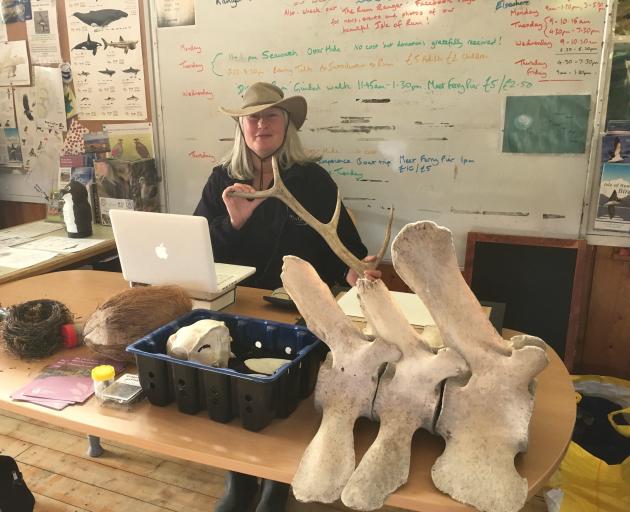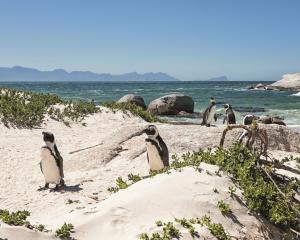
As our ferry docks in Rum’s harbour, above us tower the Cuilins and the unique geological peaks of Askival and Hallival. Formed nearly 3 billion years ago, it’s some of the oldest rock in the world. Dominating Loch Scresort’s shore — and of much more interest to me — is Rum’s eccentric Victorian oddity Kinloch Castle, a mass of pink Arran sandstone.

In 1845 the Marquis of Salisbury purchased Rum as a sporting estate, but it was George Bullough, of the Lancashire textile Bullough dynasty, whose wealth, privilege and entitlement, enabled him to fulfil his desire to create a grand hunting lodge on the island.
It is this era on Rum which is so intriguing and helps to set it apart.
Fliss, our host for the island’s B&B, meets us at the wharf; accommodation-wise, other than this there is either a bunk-style lodge or the more extreme restored Dibidil shepherds’ bothy, an 8km trek across rough terrain. Exploring the village — which is run-down in appearance — it’s hard to make sense of community dynamics, and where the 30 locals might fit in.
We relax at the Village Community Hall; everything happens here, with coffee, salmon baguettes and proprietor Kim’s fresh coconut cake, before taking the Kinloch Castle guided tour.
The castle is opulent and impressive; the Great Hall, even after all these years, still sings out for a party. It feels as if the last private owner, Lady Monica Bullough, has just left, despite her selling to the Scottish Nature Conservancy over 60 years ago. The castle is now a faded glory in varying states of decay, sadly crying out for care.

But the extravagance didn’t just end with the house itself. The setting also incorporated 250,000 tons of Ayrshire soil, which was used to create paths, avenues, lawns, a bowling green, a nine-hole golf course, a fernery and a Japanese garden complete with bridge. There were also hothouses for grapes, figs and peaches, where hummingbirds flew and turtles floated in tanks (it is said the alligators that were also briefly installed were shot because they might interfere with the comfort of the guests).
When divorcee Monique Ducarel de la Pasture — who was born in Christchurch, New Zealand, and was of French descent — married George on Rum in 1903, there was major redecorating. To this predominantly male bastion she added her feminine touch, along with a kitchen full of French chefs.

The extravagance and frivolity ended abruptly with World War 1. George’s beloved steel yacht Rhouma became enlisted as a hospital ship. The days of peacetime brought the Bulloughs back, but their annual three-week stints dwindled. When the heating malfunctioned, the plants and hummingbirds died.
Fewer staff led to overgrown gardens, collapsed conservatories, and a dry fountain. dry. By 1939 the castle was quiet.
After dinner with Fliss — no restaurants here — we spend the evening in the otter hide.

We earnestly watch for hours and see a few grey and common seals but are finally rewarded when the slice of a dorsal fin appears — a surfacing minke whale. In awe, we watch it blow.
We hire bikes from Fliss at her craft shop — it’s almost a one-woman band on the island — and bike the 13km single road uphill to Harris. This original road, constructed for George and his chums to race their sports cars from Kinloch to Harris, required a staff of 14 to keep it maintained and raked. We pass lochs, burns, sweeps of rough peat bogs and pastoral grasses where zebra-striped ponies, directly linked by ancient bloodlines to Przewalski’s horse (the stockily-built, smaller, and shorter wild horse of Central Asia) roam.

As the story goes, John made the money and George spent it. Further up the hill is the original tiled tombstone, which George’s friends had joked was reminiscent of a public lavatory. Insulted, George responded with the grander Doric temple. It’s a fine resting spot among field gentians to eat Kim’s packed lunch.

It’s sobering wandering the remains of the black-house village. We pay our respects to the Matheson family graves.
Here in 1871 Murdo and Christina Matheson lost five children to diphtheria; those remaining emigrated to New Zealand in search of a better life.
This end of the island is favoured red deer pasture and base for the 40-year red deer research project, run in conjunction with Cambridge and Edinburgh universities. We chat to one of the resident researchers who is out with her binoculars and claims she’s tracked us all day, but promises at critical moments they make a call, "on the hill", which means one must look away.

It’s hard to shake off the thought that tomorrow we will walk past Bullough’s stronghold for the last time. Rum, it’s wonderful. It’s weird.












